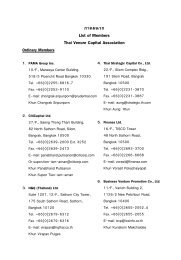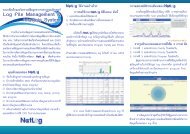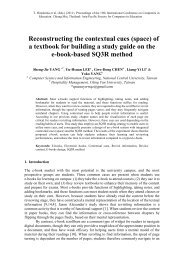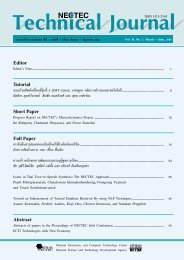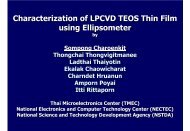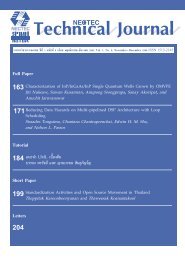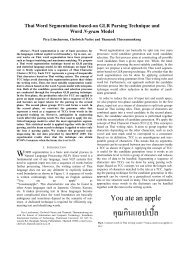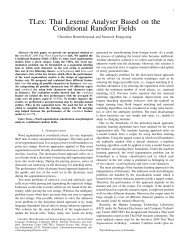IEEE 802.16 WiMax Security - Nectec
IEEE 802.16 WiMax Security - Nectec
IEEE 802.16 WiMax Security - Nectec
Create successful ePaper yourself
Turn your PDF publications into a flip-book with our unique Google optimized e-Paper software.
Agenda• Introduction to <strong>IEEE</strong> <strong>802.16</strong> <strong>WiMax</strong>• <strong>IEEE</strong> <strong>802.16</strong> <strong>Security</strong> Model• <strong>IEEE</strong> <strong>802.16</strong> <strong>Security</strong> Analysis• Conclusions
Introduction to <strong>IEEE</strong> <strong>802.16</strong> <strong>WiMax</strong>Fixed BWA(<strong>IEEE</strong> <strong>802.16</strong>)Mobile BWA(<strong>IEEE</strong> <strong>802.16</strong>e)
<strong>IEEE</strong> <strong>802.16</strong> Evolution<strong>802.16</strong>(2001)• Fixed BWA at 10-66 GHz• Line of sight<strong>802.16</strong>a(2003)• Fixed BWA at 2-11 GHz• None line of sight<strong>802.16</strong> - 2004• Revision of <strong>802.16</strong>• Combine previous <strong>802.16</strong> standards<strong>802.16</strong>e(2005 ?)• Mobile BWA based on <strong>802.16</strong>-2004(<strong>802.16</strong>a)• Roaming with vehicular speed
<strong>IEEE</strong> <strong>802.16</strong> <strong>Security</strong> Model• Standard was adopted from DOCSISspecification (e.g. cable modem spec.)Assumption: all equipments are controlled by theservice providerMay not be suitable for wireless environment• Connection oriented (i.e., Basic CID, SAID)
<strong>IEEE</strong> <strong>802.16</strong> <strong>Security</strong> Model• Connection Management connection Transport connection Identified by connection ID(CID)• <strong>Security</strong> Association (SA) Cryptographic suite (i.e.,encryption algorithm) <strong>Security</strong> Info (i.e., key, IV) Identified by SAIDSSBSSS
<strong>IEEE</strong> <strong>802.16</strong> <strong>Security</strong> Analysis• <strong>IEEE</strong> <strong>802.16</strong> security process• <strong>Security</strong> mechanisms Authentication Access control Message encryption Message modification detection (Integrity) Message replay protection Key management• Key generation• Key transport, Key protection• Key derivation• Key usage
<strong>IEEE</strong> <strong>802.16</strong> <strong>Security</strong> ProcessSSBS1. (Re) Authentication2. Data Key exchange3. Data encryption
Authentication – Vulnerabilities• No mutual authentication – Rogue BS• Limited authentication method – clientcertification• New authentication method requireschanging the authentication message
Key DerivationAuthentication Key - AK (128bits)Key Encryption Key - KEK (128bits)HMAC Key for Uplink (160 bits)HMAC Key for Downlink (160 bits)
Data Key ExchangeSSTEK Key Request[AK Sequence Number, SAID, HMAC-SHA1]TEK Key Reply[Encrypted TEK, TEK key lifetime, CBC-IV, HMAC-SHA1] ]BSTEK GenerationTEK (128bits)TEK (128bits)
Data Key Exchange• Transport Encryption Key (TEK)• TEK is generated by BS randomly• TEK is encrypted with 3DES (use 128 bits KEK) RSA (use SS’s public key) AES (use 128 bits KEK)• Key Exchange message is authenticated byHMAC-SHA1 – (provides Message Integrity andAK confirmation)
Data Key ExchangeSSTEK Key Request[AK Sequence Number, SAID, HMAC-SHA1]TEK Key Reply[Encrypted TEK, TEK key lifetime, CBC-IV, HMAC-SHA1] ]BSTEK GenerationTEK (128bits)TEK (128bits)3. Data encryption
Data Encryption• Encrypt only data message not managementmessage• DES in CBC Mode 56 bit DES key (TEK) No Message Integrity Detection No Replay Protection• AES in CCM Mode 128 bit key (TEK) HMAC-SHA1 Replay Protection using Packet Number



